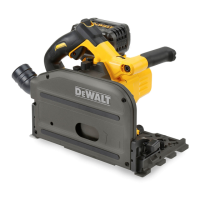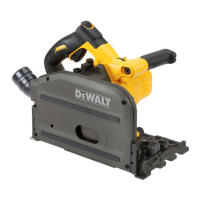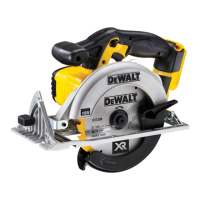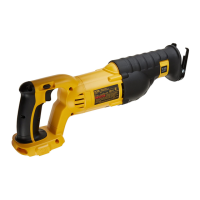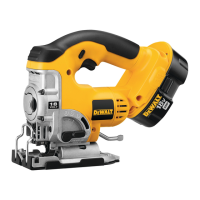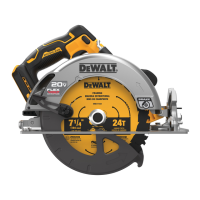19
ENGLISH
Depth of Cut Adjustment (Fig. F–H)
1. Raise the depth adjustment lever
25
toloosen.
2. To obtain the correct depth of cut, align the appropriate
mark on the depth adjustment strap
26
with notch
27
on
the upper bladeguard.
3. Tighten the depth adjustmentlever.
Kickback
Kickback is a sudden reaction to a pinched, bound or misaligned
saw blade, causing an uncontrolled saw to lift up and out of the
workpiece toward the operator. When the blade is pinched or
bound tightly by the kerf closing down, the blade stalls and the
motor reaction drives the unit rapidly back toward the operator.
If the blade becomes twisted or misaligned in the cut, the teeth
at the back edge of the blade can dig into the top surface of the
material causing the blade to climb out of the kerf and jump
back toward theoperator.
Kickback is more likely to occur when any of the following
conditionsexists.
1. IMPROPER WORKPIECE SUPPORT (FIG. X)
a. Sagging or improper lifting of the cut off piece can cause
pinching of the blade and lead to kickback (Fig.X).
b. Cutting through material supported at the outer ends
only can cause kickback. As the material weakens it sags,
closing down the kerf and pinching the blade (Fig.X).
c. Cutting off a cantilevered or overhanging piece of
material from the bottom up in a vertical direction
can cause kickback. The falling cut off piece can pinch
theblade.
d. Cutting off long narrow strips can cause kickback. The
cut off strip can sag or twist closing the kerf and pinching
theblade.
e. Snagging the lower guard on a surface below the
material being cut momentarily reduces operator control.
The saw can lift partially out of the cut increasing the
chance of bladetwist.
2. IMPROPER DEPTH OF CUT SETTING ON SAW (FIG. H)
To make the most efficient cut, the blade should protrude
only far enough to expose a tooth as shown in FigureH. This
allows the shoe to support the blade and minimises twisting
and pinching in the material. See the section titled Depth of
CutAdjustment.
3. BLADE TWISTING (MISALIGNMENT IN CUT)
a. Pushing harder to cut can cause the blade totwist.
b. Trying to turn the saw in the cut (trying to get back on
the marked line) can cause bladetwist.
c. Overreaching or operating the saw with poor body
control (out of balance), can result in twisting theblade.
d. Changing hand grip or body position while cutting can
result in bladetwist.
e. Backing up the saw to clear blade can lead totwist.
4. USE OF DULL OR DIRTY BLADES
Dull blades cause increased loading of the saw. To
compensate, an operator will usually push harder which
further loads the unit and promotes twisting of the blade
in the kerf. Worn blades may also have insufficient body
clearance which increases the chance of binding and
increasedloading.
5. RESTARTING A CUT WITH THE BLADE TEETH JAMMED
AGAINST THE MATERIAL
The saw should be brought up to full operating speed
before starting a cut or restarting a cut after the unit has
been stopped with the blade in the kerf. Failure to do so can
cause stalling andkickback.
Any other conditions which could result in pinching, binding,
twisting, or misalignment of the blade could cause kickback.
Refer to the sections Further Safety Instructions for All Saws
and Blades for procedures and techniques that will minimise
the occurrence ofkickback.
Blades
WARNING: To minimise the risk of eye injury, always
use eye protection. Carbide is a hard but brittle material.
Foreign objects in the workpiece such as wire or nails
can cause tips to crack or break. Only operate saw when
proper saw blade guard is in place. Mount blade securely
in proper rotation before using, and always use a clean,
sharpblade.
WARNING: Do not cut metal, plastic, concrete, masonry
or fiber cement materials with thissaw.
190mm Diameter
Application Teeth
Fast rip 18
Rip 24
General Purpose 40
184mm Diameter
Application Teeth
Rip 24
General Purpose 36
Finish 60
If you need assistance regarding blades, please contact your
local D
eWALTdealer.
Checking the Lower Guard (Fig.A)
1. Turn tool off and disconnect from powersupply.
2. Rotate the lower guard lever
14
from the fully closed
position to the fully openposition.
3. Release the lever and observe the guard
12
return to the
fully closedposition.
The tool should be serviced by a qualified service centre if it:
• fails to return to the fully closed position,
• moves intermittently or slowly, or
• contacts the blade or any part of the tool in all angles and
depth ofcut.
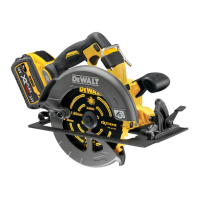
